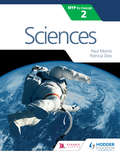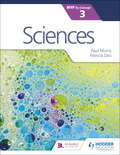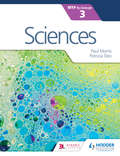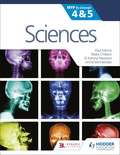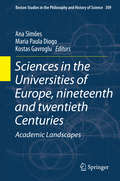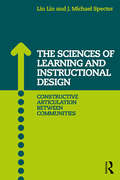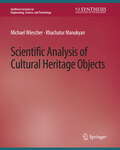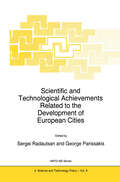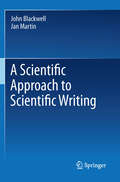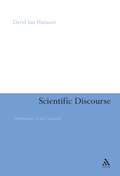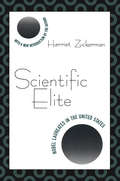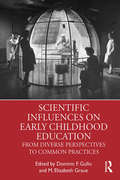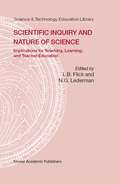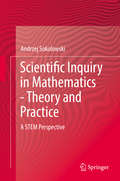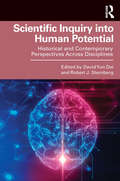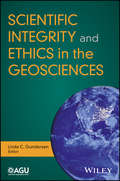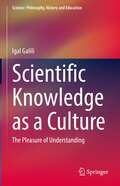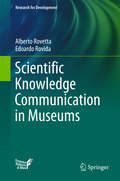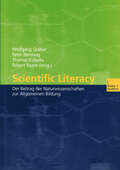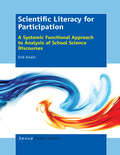- Table View
- List View
Sciences for the IB MYP 2 (PDF)
by Paul Morris Patricia DeoA concept-driven and assessment-focused approach to Sciences teaching and learning.- Approaches each chapter with statements of inquiry framed by key and related concepts, set in a global context- Supports every aspect of assessment using tasks designed by an experienced MYP educator- Differentiates and extends learning with research projects and interdisciplinary opportunities- Applies global contexts in meaningful ways to offer an MYP Sciences programme with an internationally-minded perspectiveContents list1 Where are we now and where are we going? 2 How do we map matter?3 Who are we? 4 How can we find out? 5 How does our planet work?6 How do we respond to our world?
Sciences for the IB MYP 3
by Paul Morris Patricia DeoA concept-driven and assessment-focused approach to Sciences teaching and learning.- Approaches each chapter with statements of inquiry framed by key and related concepts, set in a global context- Supports every aspect of assessment using tasks designed by an experienced MYP educator- Differentiates and extends learning with research projects and interdisciplinary opportunities- Applies global contexts in meaningful ways to offer an MYP Sciences programme with an internationally-minded perspective
Sciences for the IB MYP 3 (PDF)
by Paul Morris Patricia DeoStudent eTextbooks are downloadable versions of the printed textbook, purchased on a copy-by-copy basis and allocated to students through Dynamic Learning.A concept-driven and assessment-focused approach to Sciences teaching and learning.- Approaches each chapter with statements of inquiry framed by key and related concepts, set in a global context- Supports every aspect of assessment using tasks designed by an experienced MYP educator- Differentiates and extends learning with research projects and interdisciplinary opportunities- Applies global contexts in meaningful ways to offer an MYP Sciences programme with an internationally-minded perspectiveTeaching & Learning Resources and Whiteboard eTextbooks are also available within Dynamic Learning. Find out more by clicking on the links at the top of the page.
Sciences for the IB MYP 4&5: MYP by Concept
by Paul Morris Radia Chibani Kahina Meziane Anna MichaelidesDevelop your skills to become an inquiring learner; ensure you navigate the MYP framework with confidence using a concept-driven and assessment-focused approach to Sciences presented in global contexts.· Develop conceptual understanding with key MYP concepts and related concepts at the heart of each chapter. · Learn by asking questions for a statement of inquiry in each chapter. · Prepare for every aspect of assessment using support and tasks designed by experienced educators.· Understand how to extend your learning through research projects and interdisciplinary opportunities.· Think internationally with chapters and concepts set in global contexts.
Sciences in the Universities of Europe, Nineteenth and Twentieth Centuries: Academic Landscapes (Boston Studies in the Philosophy and History of Science #309)
by Ana Simões Maria Paula Diogo Kostas GavrogluThis book focuses on sciences in the universities of Europe in the nineteenth and twentieth centuries, and the chapters in it provide an overview, mostly from the point of view of the history of science, of the different ways universities dealt with the institutionalization of science teaching and research. A useful book for understanding the deep changes that universities were undergoing in the last years of the 20th century. The book is organized around four central themes: 1) Universities in the longue durée; 2) Universities in diverse political contexts; 3) Universities and academic research; 4) Universities and discipline formation. The book is addressed at a broad readership which includes scholars and researchers in the field of General History, Cultural History, History of Universities, History of Education, History of Science and Technology, Science Policy, high school teachers, undergraduate and graduate students of sciences and humanities, and the general interested public.
The Sciences of Learning and Instructional Design: Constructive Articulation Between Communities
by Lin Lin J. Michael SpectorThere are two distinct professional communities that share an interest in using innovative approaches and emerging technologies to design and implement effective support for learning. This edited collection addresses the growing divide between the learning sciences community and the instructional design and technology community, bringing leading scholars from both fields together in one volume in an attempt to find productive middle ground. Chapters discuss the implications of not bridging this divide, propose possible resolutions, and go on to lay a foundation for continued discourse in this important area.
The Sciences of Learning and Instructional Design: Constructive Articulation Between Communities
by Lin Lin J. Michael SpectorThere are two distinct professional communities that share an interest in using innovative approaches and emerging technologies to design and implement effective support for learning. This edited collection addresses the growing divide between the learning sciences community and the instructional design and technology community, bringing leading scholars from both fields together in one volume in an attempt to find productive middle ground. Chapters discuss the implications of not bridging this divide, propose possible resolutions, and go on to lay a foundation for continued discourse in this important area.
Scientific Analysis of Cultural Heritage Objects (Synthesis Lectures on Engineering, Science, and Technology)
by Michael Wiescher Khachatur ManukyanThe characterization of cultural heritage objects becomes increasingly important for conservation, restoration, dating, and authentication purposes. The use of scientific methods in archaeometry and conservation science has led to a significant broadening of the field. Scientific analysis of these objects is a challenging task due to their complex composition, artistic and historical values requiring the use of minimally invasive and nondestructive analytical procedures. This textbook summarizes scientific methods that are currently used to characterize objects of cultural heritage and archaeological artifacts. This book provides a brief description of the structure of matter at the molecular, atomic, and nuclear levels. Furthermore, it discusses the chemical and physical nature of materials from the molecular to the atomic and nuclear level as determined by the principles of quantum mechanics. Important aspects of natural and anthropogenic radioactivity that play a critical role for some of the analytical techniques are also emphasized. The textbook also provides principals and applications of spectroscopic methods for characterization of cultural heritage objects. It describes the technologies with specific examples for utilization of spectroscopic techniques in the characterization of paintings, books, coins, ceramics, and other objects. Analytic approaches that employ isotopes and determination of isotope ratios will be reviewed. General principles of imaging techniques and specific examples for utilization of these methods will also be summarized. In the later part of the book, a number of scientific techniques for the age determination of cultural heritage material and archaeological artifacts will be presented and discussed with specific examples.
Scientific and Technological Achievements Related to the Development of European Cities (NATO Science Partnership Subseries: 4 #9)
by L. Radautsan G. ParissakisThis volume features the proceedings of the NATO AR Workshop held in Kishinev, the capital of Moldova, a fom1er Soviet Republic in the South Eastern Europe. OUiing 3 working days 26 reports were presented, 8 of them by, or in collaboration with, speakers from Kishinev. The reports arc presented in the order they were given at the Workshop. As the topic was rather wide-ranged, all the sittings were plenmy. The opening communication was made by the Mayor of Kishinev S. Urckian, who was the Chainnan of the Organizing Committee. It was followed by other reports of general orientation. The second half of the first day was devoted to the research results and problems of the Academy of Sciences of Moldova. On the second day the Workshop was hosted by the Technical University of Moldova. At the beginning, the ceremonial sitting of its Scientific Council took place, at which two scientists were made doctors Honoris Causa of that University: Prof. K. Frolov from Russia and Prof. G.Parissakis from Greece. Then the plenary sessions continued. The round-table talk, held in the second half of the last day, appeared to be very fruitful. A relaxed and friendly atmosphere of it was appropriate for establishing closer contacts and discussing problems of mutual interest for scientists, ingineers, managerial heads and officers and businessmen.
A Scientific Approach to Scientific Writing
by John Blackwell Jan MartinThis guide provides a framework, starting from simple statements, for writing papers for submission to peer-reviewed journals. It also describes how to address referees’ comments, approaches for composing other types of scientific communications, and key linguistic aspects of scientific writing.
Scientific Discourse: Multiliteracy in the Classroom
by David Ian HanauerScientific Discourse examines the nature of scientific inquiry in the primary school classroom to show how this interacts with early literacy. Through an examination of the texts used and produced by pupils studying science the author shows how what is at work in this context of scientific discourse is actually multiliteracy. The teacher aids the pupils' learning using different forms of literacy spread across the spoken word, written text, visual text and physical action. The result of this diverse approach is a growth not only in scientific knowledge, but basic literacy. The book provides a theoretical introduction to developmental literacy theory, current positions of science education and advanced theories of multiliteracy and genre theory. The new theory of scientific discourse presented in this book will be of interest to researchers of applied linguistics, discourse analysis and education.
Scientific Elite: Nobel Laureates in the United States
by William T. GoldenScientific Elite is about Nobel prize winners and the well-defined stratification system in twentieth-century science. It tracks the careers of all American laureates who won prizes from 1907 until 1972, examining the complex interplay of merit and privilege at each stage of their scientific lives and the creation of the ultra-elite in science.The study draws on biographical and bibliographical data on laureates who did their prize-winning research in the United States, and on detailed interviews with forty-one of the fifty-six laureates living in the United States at the time the study was done. Zuckerman finds laureates being successively advantaged as time passes. These advantages are producing growing disparities between the elite and other scientists both in performance and in rewards, which create and maintain a sharply graded stratification system.
Scientific Elite: Nobel Laureates in the United States
by Harriet ZuckermanScientific Elite is about Nobel prize winners and the well-defined stratification system in twentieth-century science. It tracks the careers of all American laureates who won prizes from 1907 until 1972, examining the complex interplay of merit and privilege at each stage of their scientific lives and the creation of the ultra-elite in science.The study draws on biographical and bibliographical data on laureates who did their prize-winning research in the United States, and on detailed interviews with forty-one of the fifty-six laureates living in the United States at the time the study was done. Zuckerman finds laureates being successively advantaged as time passes. These advantages are producing growing disparities between the elite and other scientists both in performance and in rewards, which create and maintain a sharply graded stratification system.
Scientific Influences on Early Childhood Education: From Diverse Perspectives to Common Practices
by Dominic F. GulloScientific Influences on Early Childhood Education offers a new framework for examining the diverse scientific perspectives that shape early childhood education. As the field takes on an increasing role in addressing children’s educational, developmental, and environmental needs, it is critical to more fully understand and appreciate the diverse scientific roots of contemporary early childhood education. This edited collection brings together leading researchers to explain and unpack perspectives that are not often associated with early childhood education, yet have made significant contributions to its development and evolution. Essential reading for anyone working with young children, this critical and insightful text illuminates the connections between our social values, science, and research in the field.
Scientific Influences on Early Childhood Education: From Diverse Perspectives to Common Practices
by Dominic F. Gullo M. Elizabeth GraueScientific Influences on Early Childhood Education offers a new framework for examining the diverse scientific perspectives that shape early childhood education. As the field takes on an increasing role in addressing children’s educational, developmental, and environmental needs, it is critical to more fully understand and appreciate the diverse scientific roots of contemporary early childhood education. This edited collection brings together leading researchers to explain and unpack perspectives that are not often associated with early childhood education, yet have made significant contributions to its development and evolution. Essential reading for anyone working with young children, this critical and insightful text illuminates the connections between our social values, science, and research in the field.
Scientific Inquiry and Nature of Science: Implications for Teaching,Learning, and Teacher Education (Contemporary Trends and Issues in Science Education #25)
by Lawrence Flick N. G. LedermanThis book synthesizes current literature and research on scientific inquiry and the nature of science in K-12 instruction. Its presentation of the distinctions and overlaps of inquiry and nature of science as instructional outcomes are unique in contemporary literature. Researchers and teachers will find the text interesting as it carefully explores the subtleties and challenges of designing curriculum and instruction for integrating inquiry and nature of science.
Scientific Inquiry in Mathematics - Theory and Practice: A STEM Perspective
by Andrzej SokolowskiThis valuable resource provides an overview of recent research and strategies in developing and applying modelling to promote practice-based research in STEM education. In doing so, it bridges barriers across academic disciplines by suggesting activities that promote integration of qualitative science concepts with the tools of mathematics and engineering. The volume’s three parts offer a comprehensive review, by 1) Presenting a conceptual background of how scientific inquiry can be induced in mathematics classes considering recommendations of prior research, 2) Collecting case studies that were designed using scientific inquiry process designed for math classes, and 3) Exploring future possibilities and directions for the research included within. Among the topics discussed: · STEM education: A platform for multidisciplinary learning. · Teaching and learning representations in STEM. · Formulating conceptual framework for multidisciplinary STEM modeling. · Exploring function continuity in context. · Exploring function transformations using a dynamic system. Scientific Inquiry in Mathematics - Theory and Practice delivers hands-on and concrete strategies for effective STEM teaching in practice to educators within the fields of mathematics, science, and technology. It will be of interest to practicing and future mathematics teachers at all levels, as well as teacher educators, mathematics education researchers, and undergraduate and graduate mathematics students interested in research based methods for integrating inquiry-based learning into STEM classrooms.
Scientific Inquiry into Human Potential: Historical and Contemporary Perspectives Across Disciplines
by David Yun Dai Robert J. SternbergScientific Inquiry into Human Potential explores the intellectual legacy and contemporary understanding of scientific research on human intelligence, performance, and productivity. Across nineteen chapters, some of the most eminent scholars of learning and psychology recount how they originated, distinguished, measured, challenged, and adapted their theories on the nature and nurture of human potential over decades of scientific research. These accessible, autobiographical accounts cover a spectrum of issues, from the biological underpinnings and developmental nature of human potential to the roles of community, social interaction, and systematic individual differences in cognitive and motivational functioning. Researchers, instructors, and graduate students of education, psychology, sociology, and biology will find this book not only historically informative but inspiring to their own ongoing research journeys, as well.
Scientific Inquiry into Human Potential: Historical and Contemporary Perspectives Across Disciplines
by David Yun Dai and Robert J. SternbergScientific Inquiry into Human Potential explores the intellectual legacy and contemporary understanding of scientific research on human intelligence, performance, and productivity. Across nineteen chapters, some of the most eminent scholars of learning and psychology recount how they originated, distinguished, measured, challenged, and adapted their theories on the nature and nurture of human potential over decades of scientific research. These accessible, autobiographical accounts cover a spectrum of issues, from the biological underpinnings and developmental nature of human potential to the roles of community, social interaction, and systematic individual differences in cognitive and motivational functioning. Researchers, instructors, and graduate students of education, psychology, sociology, and biology will find this book not only historically informative but inspiring to their own ongoing research journeys, as well.
Scientific Integrity and Ethics in the Geosciences: With Application To The Geosciences (Special Publications #73)
by Linda C. GundersenScience is built on trust. The assumption is that scientists will conduct their work with integrity, honesty, and a strict adherence to scientific protocols. Written by geoscientists for geoscientists, Scientific Integrity and Ethics in the Geosciences acquaints readers with the fundamental principles of scientific ethics and shows how they apply to everyday work in the classroom, laboratory, and field. Resources are provided throughout to help discuss and implement principles of scientific integrity and ethics. Volume highlights include: Examples of international and national codes and policies Exploration of the role of professional societies in scientific integrity and ethics References to scientific integrity and ethics in publications and research data Discussion of science integrity, ethics, and geoethics in education Extensive coverage of data applications Scientific Integrity and Ethics in the Geosciences is a valuable resource for students, faculty, instructors, and scientists in the geosciences and beyond. It is also useful for geoscientists working in industry, government, and policymaking.Read an interview with the editors to find out more:https://eos.org/editors-vox/ethics-crucial-for-the-future-of-the-geosciences
Scientific Integrity and Ethics in the Geosciences: With Application To The Geosciences (Special Publications)
by Linda C. GundersenScience is built on trust. The assumption is that scientists will conduct their work with integrity, honesty, and a strict adherence to scientific protocols. Written by geoscientists for geoscientists, Scientific Integrity and Ethics in the Geosciences acquaints readers with the fundamental principles of scientific ethics and shows how they apply to everyday work in the classroom, laboratory, and field. Resources are provided throughout to help discuss and implement principles of scientific integrity and ethics. Volume highlights include: Examples of international and national codes and policies Exploration of the role of professional societies in scientific integrity and ethics References to scientific integrity and ethics in publications and research data Discussion of science integrity, ethics, and geoethics in education Extensive coverage of data applications Scientific Integrity and Ethics in the Geosciences is a valuable resource for students, faculty, instructors, and scientists in the geosciences and beyond. It is also useful for geoscientists working in industry, government, and policymaking.Read an interview with the editors to find out more:https://eos.org/editors-vox/ethics-crucial-for-the-future-of-the-geosciences
Scientific Knowledge as a Culture: The Pleasure of Understanding (Science: Philosophy, History and Education)
by Igal GaliliThis book, in its first part, contains units of conceptual history of several topics of physics based on the research in physics education and research based articles with regard to several topics involved in teaching science in general and physics in particular. The second part of the book includes the framework used, the approach considering science knowledge as a special type of culture – discipline-culture. Within this approach, scientific knowledge is considered as comprised of a few inclusive fundamental theories each hierarchically structured in a triadic pattern: nucleus-body-periphery. While nucleus incorporates the basic principles and body comprises their implementations in the variety of laws, models, and experiments, periphery includes concepts at odds to the nucleus. This structure introduces knowledge in its conceptual variation thus converting disciplinary knowledge to cultural-disciplinary one. The approach draws on history and philosophy of science (HPS) necessary for meaningful learning of science. It is exemplified in several aspects regarding teaching physics, presenting history in classes, considering the special nature of science, and using artistic images in regular teaching. The revealed conceptual debate around the chosen topics clarifies the subject matter for school students and teachers encouraging construction of Cultural Content Knowledge. Often missed in teachers' preparation and common curriculum it helps genuine understanding of science thus providing remedy of students' misconceptions reported in educational research.
Scientific Knowledge Communication in Museums (Research for Development)
by Alberto Rovetta Edoardo RovidaThis book explains the general principles of scientific and technical communication in the context of modern museums. It also examines, with the aid of informative case studies, the different means by which knowledge can be transmitted, including posters, objects, explanatory guidance, documentation, and catalogues. Highlighting the ever more important role of multimedia and virtual reality components in communicating understanding of and facilitating interaction with the displayed object, it explores how network communications systems and algorithms can be applied to offer individual users the information that is most pertinent to them. The book is supported by a Dynamic Museums app connected to museum databases where series of objects can be viewed via cloud computing and the Internet and printed using 3D printing technology. This book is of interest to a diverse readership, including all those who are responsible for museums’ collections, operations, and communications as well as those delivering or participating in courses on museums and their use, communication design and related topics.
Scientific Literacy: Der Beitrag der Naturwissenschaften zur Allgemeinen Bildung
by Wolfgang Gräber Peter Nentwig Thomas R. Koballa Robert H. EvansNaturwissenschaftliche Bildung steht spätestens seit den Ergebnissen von TIMSS und PISA auch in Deutschland auf dem Prüfstand. Die Ziele werden vielfach unter dem Begriff "Scientific Literacy" diskutiert, der aus dem angelsächsischen Sprachraum stammt und mit "naturwissenschaftliche Grundbildung" nur unzureichend zu übersetzen ist. Namhafte Fachdidaktiker aus Deutschland, der Schweiz und den USA beschreiben dieses Konstrukt aus unterschiedlichen Perspektiven - Verfechter und Kritiker kommen gleichermaßen zu Wort.
Scientific Literacy for Participation: A Systemic Functional Approach to Analysis of School Science Discourses
by Erik KnainScientific literacy is approached on the premise that language is key to understand the nature of both learning and participation, in scientists’ practices as well as in liberal education for citizenship. Some of the questions that are addressed in the book are: • What does it take to be able to participate in different arenas in society involving science? • How does everyday language relate to scientific language? • How can students’ texts be analyzed to gain insights into their learning? • How can images be analyzed alongside verbal language? This book offers a thorough introduction to key ideas in M. A. K. Halliday’s systemic functional grammar through examples and practical analysis. Detailed analysis is offered of science textbooks and curriculum documents, classroom talk, experimental work, and students’ discussions of complex environmental issues. Further, an analytical model guiding the design and analysis of science learning discourses is introduced. The book starts with introducing excerpts from whole-class discussions, group work, experimental reports and textbooks as text-in-context. From this starting point, key aspects of language are carefully explained. The role of grammatical metaphor in the development of science knowledge is an important topic throughout the book. Tools for analyzing multimodal representations, intertextuality and multiple voices are also among the topics covered for understanding and analyzing school science discourses.
